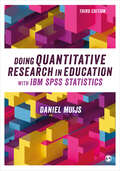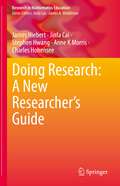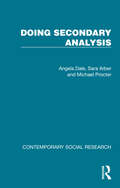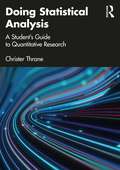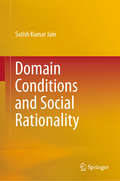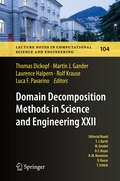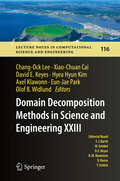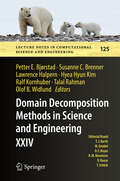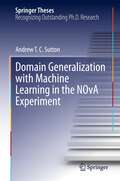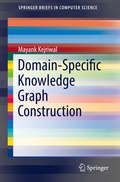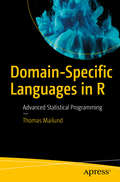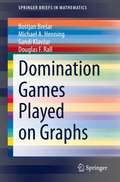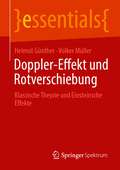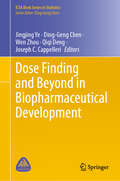- Table View
- List View
Doing Quantitative Research in Education with IBM SPSS Statistics
by Daniel MuijsThis essential guide for education students and researchers explains how to use quantitative methods for analysing educational data using IBM SPSS Statistics. By using datasets from real-life educational research, it demonstrates key statistical techniques that you will need to know, explaining how each procedure can by run on IBM SPSS Statistics. Datasets discussed in the book are downloadable, allowing you to hone your skills as you read. In this third edition, explanations have been updated with figures and screenshots from SPSS version 28, alongside a range of new research examples and updated further reading. Daniel Muijs is Dean of the Faculty of Education and Society at Academica University of Applied Sciences in Amsterdam.
Doing Research: A New Researcher’s Guide (Research in Mathematics Education)
by James Hiebert Stephen Hwang Jinfa Cai Charles Hohensee Anne K MorrisThis book is about scientific inquiry. Designed for early and mid-career researchers, it is a practical manual for conducting and communicating high-quality research in (mathematics) education. Based on the authors’ extensive experience as researchers, as mentors, and as members of the editorial team for the Journal for Research in Mathematics Education (JRME), this book directly speaks to researchers and their communities about each phase of the process for conceptualizing, conducting, and communicating high-quality research in (mathematics) education.In the late 2010s, both JRME and Educational Studies in Mathematics celebrated 50 years of publishing high-quality research in mathematics education. Many advances in the field have occurred since the establishment of these journals, and these anniversaries marked a milestone in research in mathematics education. Indeed, fifty years represents a small step for human history but a giant leap for mathematics education. The educational research community in general (and the mathematics education community in particular) has strongly advocated for original research, placing great emphasis on building knowledge and capacity in the field. Because it is an interdisciplinary field, mathematics education has integrated means and methods for scientific inquiry from multiple disciplines. Now that the field is gaining maturity, it is a good time to take a step back and systematically consider how mathematics education researchers can engage in significant, impactful scientific inquiry.
Doing Secondary Analysis (Contemporary Social Research)
by Angela Dale Sara Arber Michael ProcterOriginally published in 1988 Doing Secondary Analysis is a practical guide to the secondary analysis of large-scale survey data.At a time when funding for primary data collection was increasingly constrained, the secondary analysis of high-quality government surveys offered the social scientist an unrivalled opportunity. This volume provided a guide which moves through every stage of ‘doing secondary analysis’. The authors begin with the conceptualization of the research problem and examine all the practicalities of using both standard rectangular data and hierarchical data, and of deriving simple and complex variables. They also provide a lucid description of the hardware and software available to the secondary analyst at the time.This book successfully demonstrates the way in which secondary analysis can contribute both to the development of sociological theory and to social policy formation. The authors emphasize throughout that secondary analysis cannot be used as a short cut to quick ‘results’, but that as much care over defining the research problem and understanding the categories of data is needed as for any other kind of research.While Doing Secondary Analysis was invaluable to those about to embark upon social research, it also offered many challenges to more experienced researchers.
Doing Simple Math in Your Head
by W. J. HowardAlmost all adults suffer a little math anxiety, especially when it comes to everyday problems they think they should be able to figure out in their heads. Want to figure the six percent sales tax on a $34.50 item? A 15 percent tip for a $13.75 check? The carpeting needed for a 12½-by-17-foot room? No one learns how to do these mental calculations in school, where the emphasis is on paper-and-pencil techniques. With no math background required and no long list of rules to memorize, this book teaches average adults how to simplify their math problems, provides ample real-life practice problems and solutions, and gives grown-ups the necessary background in basic arithmetic to handle everyday problems quickly.
Doing Statistical Analysis: A Student’s Guide to Quantitative Research
by Christer ThraneDoing Statistical Analysis looks at three kinds of statistical research questions – descriptive, associational, and inferential – and shows students how to conduct statistical analyses and interpret the results. Keeping equations to a minimum, it uses a conversational style and relatable examples such as football, COVID-19, and tourism, to aid understanding. Each chapter contains practice exercises, and a section showing students how to reproduce the statistical results in the book using Stata and SPSS. Digital supplements consist of data sets in Stata, SPSS, and Excel, and a test bank for instructors. Its accessible approach means this is the ideal textbook for undergraduate students across the social and behavioral sciences needing to build their confidence with statistical analysis.
Doing Transitions in the Life Course: Processes and Practices (Life Course Research and Social Policies #16)
by Barbara Stauber Andreas Walther Richard A. SetterstenThis open access book provides a unique research perspective on life course transitions. Here, transitions are understood as social processes and practices. Leveraging the recent “practice turn” in the social sciences, the contributors analyze how life course transitions are “done.” This book introduces the concept of “doing transitions” and its implications for theories and methods. It presents fresh empirical research on “doing transitions” in different life phases (e.g., childhood, young adulthood, later life) and life domains (e.g., education, work, family, health, migration). It also emphasizes themes related to institutions and organizations, time and normativity, materialities (such as bodies, spaces, and artifacts), and the reproduction of social inequalities in education and welfare. In coupling this new perspective with empirical illustrations, this book is an indispensable resource for scholars from demography, sociology, psychology, social work and other scientific fields, as well as for students, counselors and practitioners, and policymakers.
Domain Conditions and Social Rationality
by Satish Kumar JainThis book primarily focuses on the domain conditions under which a number of important classes of binary social decision rules give rise to rational social preferences. One implication of the Arrow and Gibbard theorems is that every non-oligarchic social decision rule that satisfies the condition of independence of irrelevant alternatives, a requirement crucial for the unambiguity of social choices, and the weak Pareto criterion fails to generate quasi-transitive social preferences for some configurations of individual preferences. The problem is exemplified by the famous voting paradox associated with the majority rule. Thus, in the context of rules that do not give rise to transitive (quasi-transitive) social preferences for every configuration of individual preferences, an important problem is that of formulating Inada-type necessary and sufficient conditions for transitivity (quasi-transitivity). This book formulates conditions for transitivity and quasi-transitivity for several classes of social decision rules, including majority rules, non-minority rules, Pareto-inclusive non-minority rules, and social decision rules that are simple games. It also analyzes in detail the conditions for transitivity and quasi-transitivity under the method of the majority decision, and derives the maximally sufficient conditions for transitivity under the class of neutral and monotonic binary social decision rules and one of its subclasses. The book also presents characterizations of some of the classes of rules for which domain conditions have been derived. The material covered is relevant to anyone interested in studying the structure of voting rules, particularly those interested in social choice theory. Providing the necessary social choice theoretic concepts, definitions, propositions and theorems, the book is essentially self-contained. The treatment throughout is rigorous, and unlike most of the literature on domain conditions, care is taken regarding the number of individuals in the 'necessity' proofs. As such it is an invaluable resource for students of economics and political science, with takeaways for everyone – from first-year postgraduates to more advanced doctoral students and scholars.
Domain Decomposition Methods in Science and Engineering XXII
by Thomas Dickopf Martin J. Gander Laurence Halpern Rolf Krause Luca F. PavarinoThese are the proceedings of the 22nd International Conference on Domain Decomposition Methods, which was held in Lugano, Switzerland. With 172 participants from over 24 countries, this conference continued a long-standing tradition of internationally oriented meetings on Domain Decomposition Methods. The book features a well-balanced mix of established and new topics, such as the manifold theory of Schwarz Methods, Isogeometric Analysis, Discontinuous Galerkin Methods, exploitation of modern HPC architectures and industrial applications. As the conference program reflects, the growing capabilities in terms of theory and available hardware allow increasingly complex non-linear and multi-physics simulations, confirming the tremendous potential and flexibility of the domain decomposition concept.
Domain Decomposition Methods in Science and Engineering XXIII
by Chang-Ock Lee Xiao-Chuan Cai David E. Keyes Hyea Hyun Kim Axel Klawonn Eun-Jae Park Olof B. WidlundThis book is a collection of papers presented at the 23rd International Conference on Domain Decomposition Methods in Science and Engineering, held on Jeju Island, Korea on July 6-10, 2015. Domain decomposition methods solve boundary value problems by splitting them into smaller boundary value problems on subdomains and iterating to coordinate the solution between adjacent subdomains. Domain decomposition methods have considerable potential for a parallelization of the finite element methods, and serve a basis for distributed, parallel computations.
Domain Decomposition Methods in Science and Engineering XXIV (Lecture Notes in Computational Science and Engineering #125)
by Susanne C. Brenner Hyea Hyun Kim Olof B. Widlund Petter E. Bjørstad Lawrence Halpern Ralf Kornhuber Talal RahmanThese are the proceedings of the 24th International Conference on Domain Decomposition Methods in Science and Engineering, which was held in Svalbard, Norway in February 2017. Domain decomposition methods are iterative methods for solving the often very large systems of equations that arise when engineering problems are discretized, frequently using finite elements or other modern techniques. These methods are specifically designed to make effective use of massively parallel, high-performance computing systems. The book presents both theoretical and computational advances in this domain, reflecting the state of art in 2017.
Domain Generalization with Machine Learning in the NOvA Experiment (Springer Theses)
by Andrew T.C. SuttonThis thesis presents significant advances in the use of neural networks to study the properties of neutrinos. Machine learning tools like neural networks (NN) can be used to identify the particle types or determine their energies in detectors such as those used in the NOvA neutrino experiment, which studies changes in a beam of neutrinos as it propagates approximately 800 km through the earth. NOvA relies heavily on simulations of the physics processes and the detector response; these simulations work well, but do not match the real experiment perfectly. Thus, neural networks trained on simulated datasets must include systematic uncertainties that account for possible imperfections in the simulation. This thesis presents the first application in HEP of adversarial domain generalization to a regression neural network. Applying domain generalization to problems with large systematic variations will reduce the impact of uncertainties while avoiding the risk of falsely constraining the phase space. Reducing the impact of systematic uncertainties makes NOvA analysis more robust, and improves the significance of experimental results.
Domain-Specific Knowledge Graph Construction (SpringerBriefs in Computer Science)
by Mayank KejriwalThe vast amounts of ontologically unstructured information on the Web, including HTML, XML and JSON documents, natural language documents, tweets, blogs, markups, and even structured documents like CSV tables, all contain useful knowledge that can present a tremendous advantage to the Artificial Intelligence community if extracted robustly, efficiently and semi-automatically as knowledge graphs. Domain-specific Knowledge Graph Construction (KGC) is an active research area that has recently witnessed impressive advances due to machine learning techniques like deep neural networks and word embeddings. This book will synthesize Knowledge Graph Construction over Web Data in an engaging and accessible manner. The book will describe a timely topic for both early -and mid-career researchers. Every year, more papers continue to be published on knowledge graph construction, especially for difficult Web domains. This work would serve as a useful reference, as well as an accessible but rigorous overview of this body of work. The book will present interdisciplinary connections when possible to engage researchers looking for new ideas or synergies. This will allow the book to be marketed in multiple venues and conferences. The book will also appeal to practitioners in industry and data scientists since it will have chapters on both data collection, as well as a chapter on querying and off-the-shelf implementations. The author has, and continues to, present on this topic at large and important conferences. He plans to make the powerpoint he presents available as a supplement to the work. This will draw a natural audience for the book. Some of the reviewers are unsure about his position in the community but that seems to be more a function of his age rather than his relative expertise. I agree with some of the reviewers that the title is a little complicated. I would recommend “Domain Specific Knowledge Graphs”.
Domain-Specific Languages in R: Advanced Statistical Programming
by Thomas MailundGain an accelerated introduction to domain-specific languages in R, including coverage of regular expressions. This compact, in-depth book shows you how DSLs are programming languages specialized for a particular purpose, as opposed to general purpose programming languages. Along the way, you’ll learn to specify tasks you want to do in a precise way and achieve programming goals within a domain-specific context. Domain-Specific Languages in R includes examples of DSLs including large data sets or matrix multiplication; pattern matching DSLs for application in computer vision; and DSLs for continuous time Markov chains and their applications in data science. After reading and using this book, you’ll understand how to write DSLs in R and have skills you can extrapolate to other programming languages.What You'll LearnProgram with domain-specific languages using RDiscover the components of DSLsCarry out large matrix expressions and multiplications Implement metaprogramming with DSLsParse and manipulate expressions Who This Book Is ForThose with prior programming experience. R knowledge is helpful but not required.
Domain-informed Machine Learning for Smart Manufacturing
by Qiang HuangThis book introduces the state-of-the-art understanding on domain-informed machine learning (DIML) for advanced manufacturing. Methods and case studies presented in this volume show how complicated engineering phenomena and mechanisms are integrated into machine learning problem formulation and methodology development. Ultimately, these methodologies contribute to quality control for smart personalized manufacturing. The topics include domain-informed feature representation, dimension reduction for personalized manufacturing, fabrication-aware modeling of additive manufacturing processes, small-sample machine learning for 3D printing quality, optimal compensation of 3D shape deviation in 3D printing, engineering-informed transfer learning for smart manufacturing, and domain-informed predictive modeling for nanomanufacturing quality. Demonstrating systematically how the various aspects of domain-informed machine learning methods are developed for advanced manufacturing such as additive manufacturing and nanomanufacturing, the book is ideal for researchers, professionals, and students in manufacturing and related engineering fields.
Domesticating Youth: Youth Bulges and their Socio-political Implications in Tajikistan
by Sophie RocheMost of the Muslim societies of the world have entered a demographic transition from high to low fertility, and this process is accompanied by an increase in youth vis-à-vis other age groups. Political scientists and historians have debated whether such a "youth bulge" increases the potential for conflict or whether it represents a chance to accumulate wealth and push forward social and technological developments. This book introduces the discussion about youth bulge into social anthropology using Tajikistan, a post-Soviet country that experienced civil war in the 1990s, which is in the middle of such a demographic transition. Sophie Roche develops a social anthropological approach to analyze demographic and political dynamics, and suggests a new way of thinking about social change in youth bulge societies.
Domination Games Played on Graphs (SpringerBriefs in Mathematics)
by Michael A. Henning Sandi Klavžar Boštjan Brešar Douglas F. RallThis concise monograph present the complete history of the domination game and its variants up to the most recent developments and will stimulate research on closely related topics, establishing a key reference for future developments. The crux of the discussion surrounds new methods and ideas that were developed within the theory, led by the imagination strategy, the Continuation Principle, and the discharging method of Bujtás, to prove results about domination game invariants. A toolbox of proof techniques is provided for the reader to obtain results on the domination game and its variants. Powerful proof methods such as the imagination strategy are presented. The Continuation Principle is developed, which provides a much-used monotonicity property of the game domination number. In addition, the reader is exposed to the discharging method of Bujtás. The power of this method was shown by improving the known upper bound, in terms of a graph's order, on the (ordinary) domination number of graphs with minimum degree between 5 and 50. The book is intended primarily for students in graph theory as well as established graph theorists and it can be enjoyed by anyone with a modicum of mathematical maturity.The authors include exact results for several families of graphs, present what is known about the domination game played on subgraphs and trees, and provide the reader with the computational complexity aspects of domination games. Versions of the games which involve only the “slow” player yield the Grundy domination numbers, which connect the topic of the book with some concepts from linear algebra such as zero-forcing sets and minimum rank. More than a dozen other related games on graphs and hypergraphs are presented in the book. In all these games there are problems waiting to be solved, so the area is rich for further research. The domination game belongs to the growing family of competitive optimization graph games. The game is played by two competitors who take turns adding a vertex to a set of chosen vertices. They collaboratively produce a special structure in the underlying host graph, namely a dominating set. The two players have complementary goals: one seeks to minimize the size of the chosen set while the other player tries to make it as large as possible. The game is not one that is either won or lost. Instead, if both players employ an optimal strategy that is consistent with their goals, the cardinality of the chosen set is a graphical invariant, called the game domination number of the graph. To demonstrate that this is indeed a graphical invariant, the game tree of a domination game played on a graph is presented for the first time in the literature.
Domination in Graphs: Volume 2: Advanced Topics (Chapman And Hall/crc Pure And Applied Mathematics Ser. #209)
by TeresaW. Haynes""Presents the latest in graph domination by leading researchers from around the world-furnishing known results, open research problems, and proof techniques. Maintains standardized terminology and notation throughout for greater accessibility. Covers recent developments in domination in graphs and digraphs, dominating functions, combinatorial problems on chessboards, and more.
Don't Be Afraid of Physics: Quantum Mechanics, Relativity and Cosmology for Everyone
by Ross Barrett Pier Paolo DelsantoWith the aid of entertaining short stories, anecdotes, lucid explanations and straight-forward figures, this book challenges the perception that the world of physics is inaccessible to the non-expert. Beginning with Neanderthal man, it traces the evolution of human reason and understanding from paradoxes and optical illusions to gravitational waves, black holes and dark energy. On the way, it provides insights into the mind-boggling advances at the frontiers of physics and cosmology. Unsolved problems and contradictions are highlighted, and contentious issues in modern physics are discussed in a non-dogmatic way in a language comprehensible to the non-scientist. It has something for everyone.
Doodlebug & Dandelion: Bandits
by Charnan SimonDoodlebug’s stuff has been disappearing. He thinks his cousins, Rudyard and Dandelion, are the thieves! They decide to investigate the thefts to prove their innocence. Together, they find the real culprits. Will Rudyard and Dandelion be able to convince Doodlebug they didn't do it?
Doppler-Effekt und Rotverschiebung: Klassische Theorie und Einsteinsche Effekte (essentials)
by Helmut Günther Volker MüllerDer Doppler-Effekt ist die Frequenzänderung von Wellen bei einer Relativgeschwindigkeit von Sender und Empfänger. So wird die Sirene einer Feuerwehr bei einer Vorbeifahrt deutlich tiefer. Der klassische Doppler-Effekt erlaubt es, den Bewegungszustand des Trägermediums der Wellen zu bestimmen. Für Licht im Vakuum ist die relativistische Gangverzögerung einer bewegten Uhr zu berücksichtigen. Die Frequenzverschiebung hängt dann nur von der Relativgeschwindigkeit ab. Es gibt keinen Bewegungszustand des Vakuums. Der Leser wird in die Lichtausbreitung in Gravitationsfeldern eingeführt. Die Autoren demonstrieren, dass Licht von kompakten Quellen eine gravitative Rotverschiebung erfährt und dass um Schwarze Löcher eine unendliche Rotverschiebung zu beobachten ist. Der Leser erfährt, warum im Kosmos zusätzlich eine kosmologische Rotverschiebung auftritt.
Dorothy Vaughan: NASA's Leading Human Computer (Movers, Shakers, and History Makers)
by Deirdre R. HeadIn 1949, Dorothy Vaughan became the first African American woman to lead a team at NASA's Langley Research Center. Her work as a mathematician was an important part of helping the United States explore space. Learn more about Vaughan's life as a famous mathematician!
Dosage Calculations Made Easy: Solving Problems Using Dimensional Analysis
by Gloria P. CraigStraightforward, approachable, and rich with practice opportunities, Dosage Calculations Made Easy: Solving Problems Using Dimensional Analysis, 8th Edition, trains students to confidently calculate accurate medication dosages and fosters the critical-thinking capabilities essential to their clinical success. From basic math functions and measurement systems to complex problem-solving methods, this up-to-date, simple-to-use skill-building guide provides a proven framework for understanding and makes it easier than ever to master effective dosage calculation and drug administration processes.
Dose Finding and Beyond in Biopharmaceutical Development (ICSA Book Series in Statistics)
by Ding-Geng Chen Joseph C. Cappelleri Wen Zhou Jingjing Ye Qiqi DengThis book covers topics in 2 parts: 1) Review of FDA Guidance, 2) Novel Designs and Analyses. While covering basic principles of dose finding, this book details advancements made in drug development. Finding the right dose(s) is one of the most important objectives in new drug development. In Phase I clinical development, one of the objectives is to escalate test doses from low to high. The low doses should be safe, then escalate up to the maximally tolerable dose (MTD). Phase Ⅱ clinical trials then lower test doses to the minimal efficacious dose (MinED). Dose range of a study drug can be thought of as the doses between MinED and MTD. From this dose range, one or a few doses are selected for Phase Ⅲ confirmation. In practice, dose finding is a very difficult in every phase of clinical development for new drugs. The editors brought distinguished researchers and practitioners in biopharmaceuticals and universities, to discuss the statistical procedures, useful methods, and their novel applications in dose finding. The chapters in the book present emerging topics in dose-finding and related interdisciplinary areas. This timely book is a valuable resource to stimulate the development of this growing and exciting field in drug development.
Dose-Finding Designs for Early-Phase Cancer Clinical Trials: A Brief Guidebook to Theory and Practice (SpringerBriefs in Statistics)
by Shigeyuki Matsui Akihiro Hirakawa Takashi DaimonThis book provides a comprehensive introduction to statistical methods for designing early phase dose-finding clinical trials. It will serve as a textbook or handbook for graduate students and practitioners in biostatistics and clinical investigators who are involved in designing, conducting, monitoring, and analyzing dose-finding trials. The book will also provide an overview of advanced topics and discussions in this field for the benefit of researchers in biostatistics and statistical science. Beginning with backgrounds and fundamental notions on dose finding in early phase clinical trials, the book then provides traditional and recent dose-finding designs of phase I trials for, e.g., cytotoxic agents in oncology, to evaluate toxicity outcome. Included are rule-based and model-based designs, such as 3 + 3 designs, accelerated titration designs, toxicity probability interval designs, continual reassessment method and related designs, and escalation overdose control designs. This book also covers more complex and updated dose-finding designs of phase I-II and I/II trials for cytotoxic agents, and cytostatic agents, focusing on both toxicity and efficacy outcomes, such as designs with covariates and drug combinations, maximum tolerated dose-schedule finding designs, and so on.
Dose-Response Analysis Using R (Chapman & Hall/CRC The R Series)
by Christian Ritz Signe Marie Jensen Daniel Gerhard Jens Carl StreibigNowadays the term dose-response is used in many different contexts and many different scientific disciplines including agriculture, biochemistry, chemistry, environmental sciences, genetics, pharmacology, plant sciences, toxicology, and zoology.In the 1940 and 1950s, dose-response analysis was intimately linked to evaluation of toxicity in terms of binary responses, such as immobility and mortality, with a limited number of doses of a toxic compound being compared to a control group (dose 0). Later, dose-response analysis has been extended to other types of data and to more complex experimental designs. Moreover, estimation of model parameters has undergone a dramatic change, from struggling with cumbersome manual operations and transformations with pen and paper to rapid calculations on any laptop. Advances in statistical software have fueled this development.Key Features: Provides a practical and comprehensive overview of dose-response analysis. Includes numerous real data examples to illustrate the methodology. R code is integrated into the text to give guidance on applying the methods. Written with minimal mathematics to be suitable for practitioners. Includes code and datasets on the book’s GitHub: https://github.com/DoseResponse. This book focuses on estimation and interpretation of entirely parametric nonlinear dose-response models using the powerful statistical environment R. Specifically, this book introduces dose-response analysis of continuous, binomial, count, multinomial, and event-time dose-response data. The statistical models used are partly special cases, partly extensions of nonlinear regression models, generalized linear and nonlinear regression models, and nonlinear mixed-effects models (for hierarchical dose-response data). Both simple and complex dose-response experiments will be analyzed.
